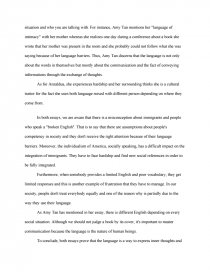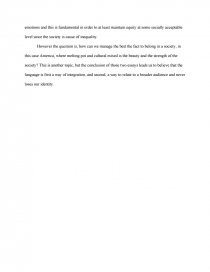Analysis of Amy Tam and Gloria Anzaldua
Essay by chameau • February 13, 2013 • Essay • 732 Words (3 Pages) • 3,230 Views
Analysis of Amy Tam and Gloria Anzaldua
A short sighed vision of "Mother Tongue" and "How to Tame a Wild Tongue"
Both articles, "Mother Tongue" by Amy Tam and "How to Tame a Wild Tongue" by Gloria Anzaldua, raised a rhetorical question in order to make a point about exploring a new language and to confront the possibility of being an outsider. Those two articles emphasize the fact that we all unconsciously develop different ideas through our language and categorized us by the way we speak. Amy Tam and Gloria Anzaldua explain in their essay how not being able to speak a proper English became difficult in order to handle everyday situations, and has an impact on preserving a culture.
First of all, both essays are written by two women that were born in America but are in some ways considered stranger to American culture because of their language or ethnic backgrounds. In the "Mother Tongue" by Amy Tan, the author actually masters the English language but experiences with her mother's "broken English" the struggle with social interactions and language barriers.
On the other hand, in the essay "How to Tame a Wild Tongue", Gloria Anzaldua considers herself as a Mexican-American Chicana that obviously doesn't really belong to any culture. Indeed, she would like to preserve her native culture by speaking Spanish but she lives in America and as her teacher said, "if you want to be American, speak 'American.' If you don't like it, go back to Mexico where you belong." Those two essays draw a conclusion rather regrettable about the problem of ethnic-based exclusion through a language that some people don't necessarily master.
Moreover, they both express how different the language could be depending on the situation and who you are talking with. For instance, Amy Tan mentions her "language of intimacy" with her mother whereas she realizes one day during a conference about a book she wrote that her mother was present in the room and she probably could not follow what she was saying because of her language barriers. Thus, Amy Tan discerns that the language is not only about the words in themselves but mostly about the communication and the fact of conveying informations through the exchange of thoughts.
As for Anzaldua, she experiences hardship and her surrounding thinks she is a cultural traitor for the fact she uses both language mixed with different person depending on where they come from.
In both essays, we are aware that there is a misconception about immigrants and people who speak a "broken English". That is to say that there are assumptions about people's competency in society and they don't receive the right
...
...


